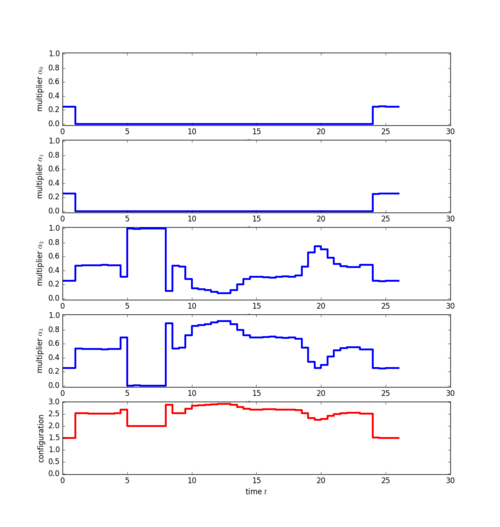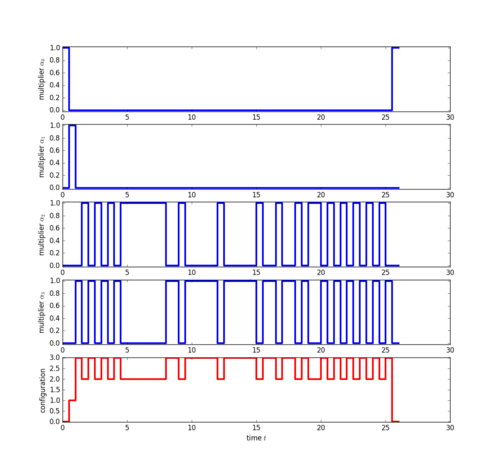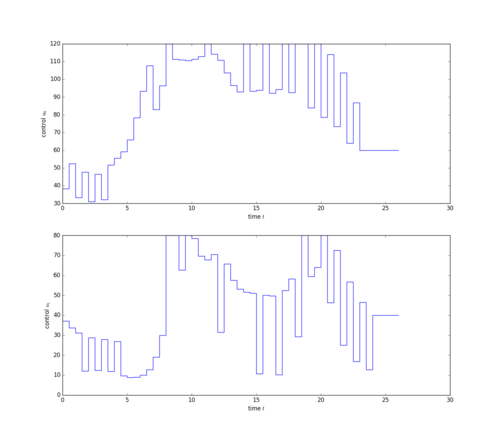Control of Transmission Lines
This problem was provided by Göttlich, Potschka, and Teuber [Goettlich2018]Author: G{\"o}ttlich, Simone; Potschka, Andreas; Teuber, Claus
Institution: University of Mannheim
Note: Optimization Online 6312
Title: A partial outer convexification approach to control
transmission lines
Url: http://www.optimization-online.org/DB_HTML/2017/11/6312.html
Year: 2018 . It is governed by a 2x2-system of conservation laws based on the telegraph equations for single transmission lines, which are then connected to form a network. The objective is to minimize the quadratic deviation of the load delivered to customer nodes from their demand by continuously controlling the power inflow to the network at the energy producer nodes and by discrete but time-varying switches at the coupling nodes inside the network.
. It is governed by a 2x2-system of conservation laws based on the telegraph equations for single transmission lines, which are then connected to form a network. The objective is to minimize the quadratic deviation of the load delivered to customer nodes from their demand by continuously controlling the power inflow to the network at the energy producer nodes and by discrete but time-varying switches at the coupling nodes inside the network.
Contents
Mathematical formulation
The dynamics on the  -th transmission line with spatial variable
-th transmission line with spatial variable ![x \in [0, l_r]](https://mintoc.de/images/math/e/f/d/efd5fa8c7741291758db47bbe865fd9c.png) , temporal variable
, temporal variable ![t \in [0, T]](https://mintoc.de/images/math/e/6/6/e66a2b7fedcba80ccb192b87440f8d9c.png) , and state variable
, and state variable  containing the characteristic variables for right-traveling and left-traveling components are given by the hyperbolic PDE system
containing the characteristic variables for right-traveling and left-traveling components are given by the hyperbolic PDE system

with a diagonal 2x2-matrix  and a symmetric matrix
and a symmetric matrix  . We combine all
. We combine all  single line states to a large state vector
single line states to a large state vector  to obtain the system
to obtain the system

and formulate the coupling between the lines and the continuously controlled power inflow  as boundary conditions involving distribution matrices
as boundary conditions involving distribution matrices  , which depend on a discrete switching signal
, which depend on a discrete switching signal  , and constant matrices
, and constant matrices  of size
of size  according to
according to

The continuous control  is subject to simple bounds.
is subject to simple bounds.
The objective is to track the given demands  of consumers, which can be formulated as
of consumers, which can be formulated as

where  is the set of consumer nodes and
is the set of consumer nodes and  is the set of all lines adjacent to vertex
is the set of all lines adjacent to vertex  .
.
Parameters
A detailed account of the network structures and parameter settings can be found in [Goettlich2018]Author: G{\"o}ttlich, Simone; Potschka, Andreas; Teuber, Claus
Institution: University of Mannheim
Note: Optimization Online 6312
Title: A partial outer convexification approach to control
transmission lines
Url: http://www.optimization-online.org/DB_HTML/2017/11/6312.html
Year: 2018 and in the source code below.
and in the source code below.
Discretization
The mixed-integer variables  are transcribed via Partial Outer Convexification and the dynamics are discretized using Finite Volumes with upwind fluxes for the characteristic variables and explicit first-order time-stepping.
are transcribed via Partial Outer Convexification and the dynamics are discretized using Finite Volumes with upwind fluxes for the characteristic variables and explicit first-order time-stepping.
Reference Solution
We consider an extended tree network with 2 producers, 4 consumers and real-world demand data.
After partial outer convexification (POC) and discretization, Ipopt delivers an NLP solution with objective value 2.804 and the following relaxed POC multipliers:

Sum-Up Rounding with SOS1-constraint delivers the following integer feasible POC multipliers:

Reoptimization with fixed Sum-Up Rounding decisions delivers an objective value of 3.152 and the following controls:

The next figure compares the consumer demands with the obtained power delivery.

Source Code
The C++ code for the results in the paper is not publicly available, but a more user-friendly Python/CasADi-Version (without dwell-time constraints) is available on GitHub/poc-transmission-lines.
References
| [Goettlich2018] | G{\"o}ttlich, Simone; Potschka, Andreas; Teuber, Claus (2018): A partial outer convexification approach to control transmission lines. University of Mannheim. |  |